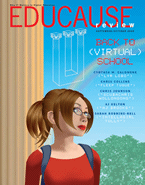The EDUCAUSE Review for September/October 2008 was released recently. For those unfamiliar with the publication, it is an “award-winning magazine for the higher education IT community”. It is published bimonthly in print and online. EDUCAUSE itself is “a nonprofit association whose mission is to advance higher education by promoting the intelligent use of information technology.”
Below are three features from the EDUCAUSE Review, précised:
1. Virtual Worlds? “Outlook Good†AJ Kelton (“AJ Brooksâ€)
AJ Kelton poses this question: Are Virtual Environments (VEs) viable teaching and learning environments?
Kelton’s perspective is that Second Life is the current reigning champion, having both multitudes of educational folk working within it, and having brought the concept of VEs to the mainstream. He goes on to list many of the other VEs in the educational domain, and points out that there has been interest in the educational value of VEs all across the globe.
Kelton mentions Media Grid and its Immersive Educational Initiative, and their continuing work in forming standards and best practices, and creating interoperability for VEs with an educational bent.
Under the challenges and drawbacks section, Kelton lists:
- Perceptual: VEs are still treated as ‘games’ by those with no personal experience; ‘fun’ is not expected to be a part of education, so anything that could be construed as being enjoyable is suspect.
- Technical: Collaborative tools (especially for working with text) and interoperability will be the greatest challenges we will face; other technical considerations will work themselves out over time as broadband services and hardware become cheaper and more accessible.
- Operational: The learning curve for VEs is steep. There are often technical difficulties with VEs, especially those that are more ‘experimental’. With younger age groups particularly, there are legal restrictions.
- Pedagogical: Each institution must decide for itself whether the tool is appropriate for them, and whether they can sort out methods of assessment.
In conclusion, Kelton seems to think that VEs have a solid future in education – but that the extent of their involvement is as yet unknown and unforeseeable.
2. Higher Education as Virtual Conversation Sarah Robbins-Bell (SL: Intellagirl Tully)
Sarah Robbins-Bell turns a deft hand to answering the question: how can we increase student involvement? She feels that emergent social media are key in turning “passive, knowledge-receiving students into active, knowledge-making students.” The more conversations we can get going, the more student involvement there will be. As levels of participation increase, students’ knowledge will increase in active ways.
On the topic of why there has been a slow increase in the use of social media in education: “I think the problem is that our pedagogy often isn’t ready for an increase in conversation.”
Robbins-Bell states that the best way to integrate social media into education is to take one form at a time: she begins with ‘Virtual Worlds’. She then lists the characteristics of Virtual Worlds, and why they work for educational purposes.
- Persistence: A virtual world can be used at any time, whether or not other avatars are there.
- Multi-user: Communication exists between users synchronously.
- Avatars: Avatars with a flexible appearance allow play with identity (roleplaying). Cultural literacy can be studied and learned from them.
- Wide Area Network: Students can reach out and communicate with students and teachers at a wide geographical divide.
She goes on to caution that instructors will need to come to an acceptance of the lessening of control that they have in this environment, but notes that this can produce useful results: more communication and less sterility.
3. Looking to the Future: Higher Education in the Metaverse Chris Collins (SL: Fleep Tuque)
Chris Collins examines the place of higher education within the arena of VEs.
Collins follows the development of VEs with regards to major corporations (IBM is working towards people coming together virtually to save them from having to be geographically congruent), industrial giants (Seimens and the University of Cincinnati are working together to allow models created in 3D software packages to be able to be imported into VEs), and governmental departments (simulations of weather phenomena, natural disasters, and workplace training scenarios carried out in VEs).
Collins’ expectation of higher education is that it will produce people ready to become employees in this virtually aware workplace.
Collins then covers the typical obstacles faced by educational facilities in attempting to provide sufficient learning resources for their students, whether they be learning on campus or by distance education.
She finishes by stating that the optimal goal is for students to have fostered within them an interest in lifelong learning, which can possibly be achieved through the technology of VEs – education through this format create more personal autonomy and a greater sense of personal investment.
The other two features from this edition, also worthy of note:
Educational Frontiers: Learning in a Virtual World Cynthia M. Calongne (SL: Lyr Lobo)
Drawing a Roadmap: Barriers and Challenges to Designing the Ideal Virtual World for Higher Education Chris Johnson (SL: ScubaChris Wollongong)
Sources:
September/October 2008 issue of EDUCAUSE Review
EDUCAUSE Review: Back to (Virtual) School (Chris Collins’ original post).

Speak Your Mind